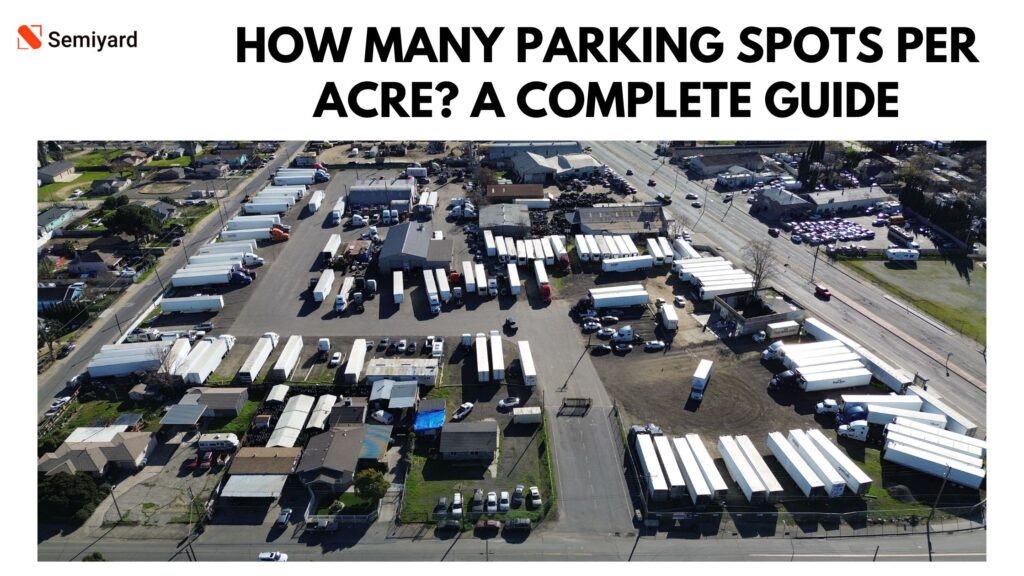
When planning a parking lot—whether it’s for cars or trucks—understanding how many vehicles can fit in a given area is crucial. Whether you’re a developer, truck yard owner, or a landowner exploring a new investment opportunity, knowing how many parking spots fit in an acre helps you estimate land use, design layout, and potential revenue.
Let’s break it all down: how many cars or semi-trucks can you park on an acre of land?
How Big Is an Acre, Really?
Before we jump into numbers, here’s a quick refresher.
One acre is equal to 43,560 square feet. However, you can’t dedicate every square inch to parking spaces. Access lanes, turning space, landscaping, lighting poles, and sometimes setbacks or drainage areas all reduce usable square footage.
On average, 70% to 85% of an acre can be used for actual parking, depending on layout and local regulations.
Car Parking: How Many Spots Fit in an Acre?
For standard car parking, the most commonly used dimensions for a single parking stall are 9 feet wide by 18 feet deep, totaling 162 square feet. But that’s just the stall itself.
When you factor in circulation space—like driving lanes, turning zones, and landscaping—the average used per car jumps up to 300–350 square feet.
So how many car spots per acre?
- Minimum density (tight layout): ~130–140 cars per acre
- Standard design: ~100–115 cars per acre
With wider lanes or landscaping: ~80–90 cars per acre
Factors that influence this:
- Angle of parking: Angled parking uses space differently than perpendicular layouts
- Drive aisle width: 20–24 feet is common for two-way traffic
- Local codes: Some cities require green buffers or fire lanes
For large retail parking lots or office buildings, designers often aim for 100–110 cars per acre as a good balance of capacity and safety.
Truck Parking: How Many Semis Fit in an Acre?
Now for the big rigs.
A typical semi-truck with a trailer requires a space of 12 feet wide by 75–80 feet long, depending on local design standards. That’s 900 to 1,000 square feet per stall—without counting maneuvering space.
When factoring in drive lanes and turning radius, each truck space can consume 1,200 to 1,500 square feet of land.
So how many trucks fit in an acre?
- Efficient layout (pull-through, minimal landscaping): 30–35 trucks
- Standard back-in layout: 25–30 trucks
Loose layout or required large turning areas: 20–25 trucks
Example Layout:
A rectangular yard with pull-through rows, 80 feet deep and 12 feet wide, can line up trucks in 2 rows per drive aisle. With well-planned turns and drive lanes, 30–35 trucks per acre is a realistic upper limit.
Why Layout Matters More Than Raw Space
You might think, “Can’t I just divide total square footage by stall size?” It’s not quite that simple.
A well-designed parking area takes into account:
- Turning radius (especially important for semi-trucks)
- Access lanes (must be wide enough for safe maneuvering)
- Ingress/egress points (how drivers enter and exit)
- Fire access and safety regulations
- Drainage systems and easements
- Lighting pole placements or fencing
That’s why two identical plots of land may fit vastly different numbers of vehicles depending on how they’re laid out.
Optimizing Land Use: Tips for More Parking Spots Per Acre
To maximize parking efficiency—especially for truck yards—consider these tips:
- Use pull-through designs to eliminate backing up
- Minimize wasted aisle space but maintain maneuverability
- Plan for one-way traffic if space is tight
- Avoid unnecessary landscaping islands
- Consult with layout experts or use CAD-based planning tools
Investing in smart layout design can help you squeeze in 10–15% more parking without compromising safety.
Who Needs to Know This?
This info isn’t just useful for architects or planners. If you’re in any of the following categories, understanding parking per acre is vital:
- Truck yard developers or owners planning new lots
- Fleet operators looking to lease or expand
- Landowners evaluating parking as a revenue opportunity
- Real estate investors exploring logistics-related properties
For example, if you’re converting vacant land into a commercial truck yard, and can fit 30 trucks per acre, charging $250/month per truck could generate $7,500 per acre, per month—or $90,000 per year from a single acre.
Multiply that by 5 acres and you’re looking at $450,000 annual revenue—just from parking.
Final Thoughts: Efficiency Is Profit
Whether you’re dealing with cars or commercial trucks, understanding how many vehicles you can fit on an acre is the first step to maximizing land use, meeting code requirements, and estimating revenue potential.
If you’re developing a yard or just exploring options, a smart layout can mean thousands of dollars more per month in income.
Need Help Planning Your Truck Yard?
If you want expert help designing a yard that maximizes truck parking spots and revenue potential, reach out to Semiyard—leaders in optimizing truck parking yards across the country.


